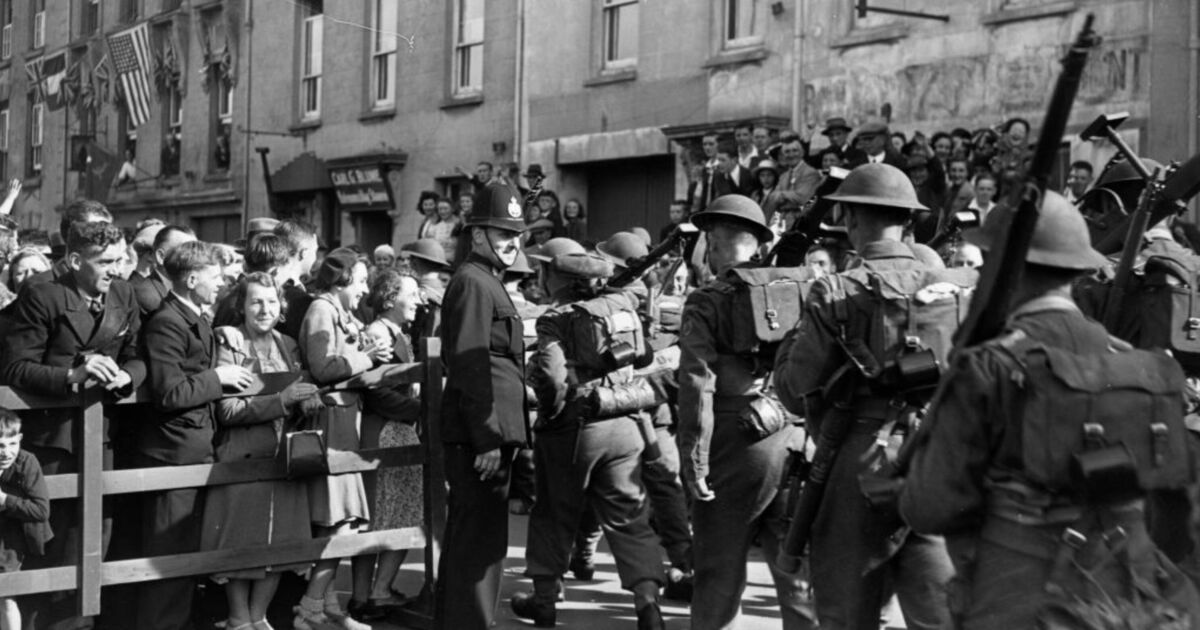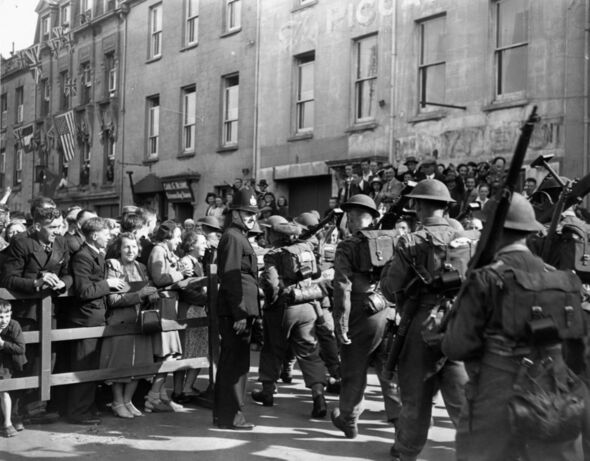
Crowds welcome British troops to Jersey following the liberation of the Channel Islands (Image: Getty)
Factory girl Stella Perkins recalled frenzied celebrations: “It was a crazy mood, absolutely crazy. There was loud music everywhere. Everybody was shouting and dancing.” Illicit radios and gramophone players were brought out of hiding, as were bottles of alcohol squirreled away for the occasion. The curfew and blackout were forgotten as parties went into the night.
But these VE Day celebrations were hundreds of miles from London and a day later – to mark the liberation of the only part of Britain occupied by Germany, the Channel Islands, which had been under the Nazi jackboot since June 1940. Apart from a few commando raids, the islands were ignored by the British while the Nazis built massive concrete defences. Wartime leader Winston Churchill had taken the hard decision at the start of the war that Britain could not realistically defend the islands, and thousands were evacuated before the Nazis arrived.
Adolf Hitler decreed that it would be a “model occupation” with his troops paying local shopkeepers while leaving civil government largely in place as puppet administrators. Yet nothing could hide the reality of a military occupation – radios confiscated, a free press abolished, strict rationing, travel bans and any objection to the Nazi jackboot rigorously crushed.
And it was hardly bloodless. At least 32 Islanders died in Nazi concentration and prison camps for offences including cutting telegraph wires, owning a radio, producing leaflets and, in the case of one female Jersey hotel worker, for slapping a German soldier who made improper advances. Up to 3,000 islanders were sent to work camps across Europe. Three Jewish women were sent to Auschwitz where they died, and others simply disappeared in dawn roundups. At least 700 slave workers, mainly from Ukraine, died building concrete tunnels and other Atlantic Wall defences on Alderney alone.
Across all the islands the death toll, including accidents and starvation, may have topped 3,000 though it remains a moot point among historians. Jersey resistance leader Norman Le Brocq was forever bitter towards Island police and ministers for collaborating.
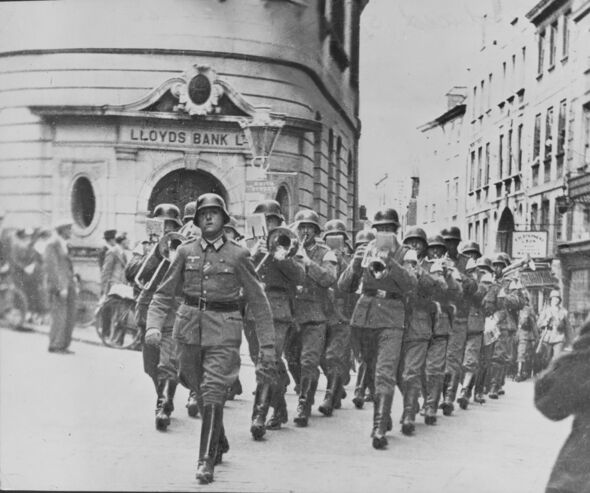
Germans marching through Guernsey during the Occupation of the Channel Islands (Image: Getty)
Don’t miss…
We made 6 wartime recipes for VE Day including cake, pie and more [LATEST]
Defeat of Hitler remains greatest chapter in our island nation’s story [LATEST]
But as the war progressed, the biggest hardship was hunger as supply blockades on Nazi Europe intensified. Families scrabbled to find edible roots and children grew painfully thin. During the bitter 1944-45 winter, the British allowed Red Cross parcels to be ferried across the Channel as both the civilian populations and the occupiers faced starvation. But liberation would have to wait until the war in Europe was won.
On D-Day on June 6, 1944, the islands and their 40,000-strong German garrison were bypassed by Allied forces. That September, British aircraft dropped leaflets printed in German almost every night calling for surrender. And on September 22, an unarmed air-sea rescue launch travelled from the liberated coast of France to near St Martin’s Point off Guernsey to negotiate under a white flat, but all such entreaties were rejected by the garrison.
Operation Constellation, a military reconquest of the islands drawn up in 1943 involved a three-pronged attack on 27,000 well-dug-in Wehrmacht troops on Jersey, Guernsey and Alderney in the expectation of fanatical resistance. Instead, Hitler’s sordid suicide shattered morale amongst half-starved enemy troops. Union Jack flags began appearing and the demoralised German garrisons took no action.
When VE Day came on May 8, the Nazis released all British, French and American prisoners of war held in the islands. Radios, which had been banned for five years, were connected to loudspeakers so islanders could hear Churchill’s victory speech in which he said that “our dear Channel Islands are free today”.
By then, British destroyers Beagle and Bulldog had approached the islands in an operation codenamed Omelette and the German commander confirmed by radio that they would not be fired upon.
The following morning, on May 9, a junior German officer came aboard HMS Bulldog to be handed the Allied surrender terms. Later a German minesweeper approached Bulldog and in the officers’ wardroom German second-in-command Siegfried Heine was asked if he would accept unconditional surrender. He replied: “Ja.”
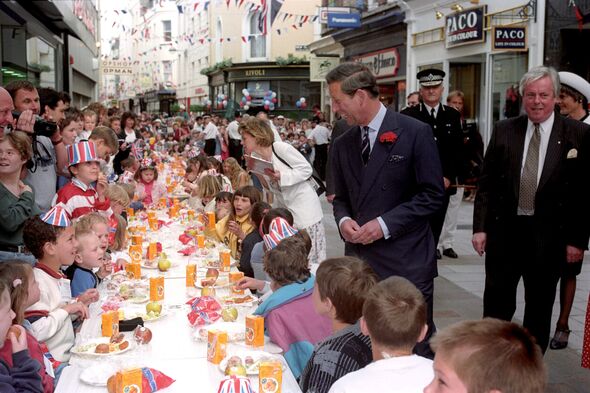
The then Prince of Wales at a street party in Jersey marking the 50th anniversary of VE Day, 1995 (Image: PA)
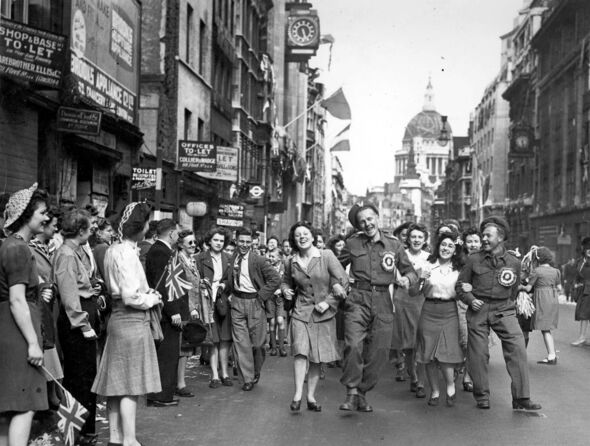
VE Day in Fleet Street, London, a day before the Channel Islands were liberated (Image: Popperfoto via Getty)
That evening, a large landing craft carrying 200 British servicemen landed on Jersey during an RAF fly-past and additional 160 were landed on Guernsey. The first place liberated in Jersey was the GPO repeater station; the lineman had been stranded during the original invasion, and he told the German officer in charge that he was taking the building back. They did not argue.
The first 30 British troops, including some islanders who had previously escaped the Occupation, marched to the Pomme d’Or Hotel. Girls covered them in kisses, slowing them to 100 yards an hour. The swastika was torn down and a Union Flag draped from the hotel balcony. British Sapper Eric Walker, who stayed in Jersey after the war, remembered his commanding officer warning him on landing: “Don’t annoy the enemy, there’s lots of them and only a few of you.”
Schoolgirl Barbara Chiang, 12, watched the liberation from a Jersey harbour: “On my left was a German soldier on duty. He was standing with his rifle at attention and watching the ships.
“I heard this clicking going on. He had come to attention, taken his rifle off and put it on the wall, took his hat off, clicked his heels and then stood at ease. That was a moment I would never forget, it was a surrender and the end of the occupation.”
As British troops marched through island capital St Helier tossing sweets to children, a Boys Brigade band played God Save the King and townspeople showered them with gifts. In all, around 91,000 islanders had survived. But there was a darker side to the liberation. Several young women accused of being too friendly with Germans were assaulted, at least one was stripped naked and had her head shaved; others had to be protected by British soldiers.
Over the next few weeks, most of the German garrison were sent to join their 400,000 POWs in Britain, apart from a few thousand kept back to help the clean-up. Teenager Kathleen Whitley, who had spent seven months in jail for painting V for Victory signs on walls, felt some pity for them, saying: “They looked so dejected and so bowed down, I felt sorry for them.”
Her view was not widely shared – at bonfire parties for decades afterwards the Guy Fawkes effigies were dressed in German uniforms. Minefields were cleared, beach obstacles and barbed wire removed, docks repaired, and war profiteers taxed by a temporary military government. Weekly rations delivered tea, chocolate, soap powder, lard, sugar, biscuits, cereals and rice to famished civilians.
The islands were covered in discarded weapons and children threw grenades across the seashore. Several were badly injured by a booby-trapped rubber dinghy. Several thousand evacuated and deported civilians returned.
John Helyer, just eight when he was evacuated to near Manchester, recalled: “I remember getting off the boat at St Peter Port and didn’t know who my parents were, and then waiting for ages until my parents eventually recognised me. My parents couldn’t understand me because I had a Lancashire accent…”
